 |
||||||||||||||||||||||||
 |
 |
|||||||||||||||||||||||
 |
||||||||||||||||||||||||
 |
 |
 |
 |
|||||||||||||||||||||
| 2015 CIRCLES | 2014 CIRCLES | 2013 CIRCLES | 2012 CIRCLES | |||||||||||||||||||||
|
||||||||||||||||||||||||
 |
 |
|||||||||||||||||||||||

|
Ground Report – Milk Hill, Nr. Stanton St. Bernard, Wiltshire, 30/05/05This formation is a prime example of the variation in design we have come to expect from the phenomenon, although we are always surprised by many each and every year, this being no exception. Located below Milk Hill, in a field of fairly young barley, this crop circle, (and I use the term ‘circle’ loosely!), can be seen from a long way off. Although not huge in size, the large areas of flattened crop mean that this formation is striking and eye-catching even from Adam’s Grave which is quite some distance away. Comprising three sections of flattened crop separated by a standing wall, and positioned with its base on the edge of a tramline, my first thought was that it resembled a church window. 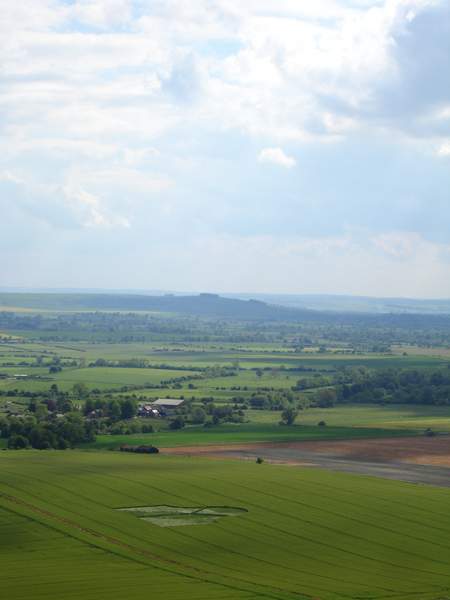
This effect is enhanced by the way the crop is laid in different directions, reflecting the sunlight to create more patterns within each section. How nice it is to be able to walk easily into and through the field without having to battle with any overgrown crop. And then whilst inside, to be able to see the whole design! On entering the formation I met Steve and Karen from Temporary Temples, and the team from Crop Circle Connector, making this crop circle not just a meeting place for people from all walks of life as I have noted before, but also for people who run websites, three websites, in a crop circle with three sections! Significant probably only in my mind, but worth pointing out! 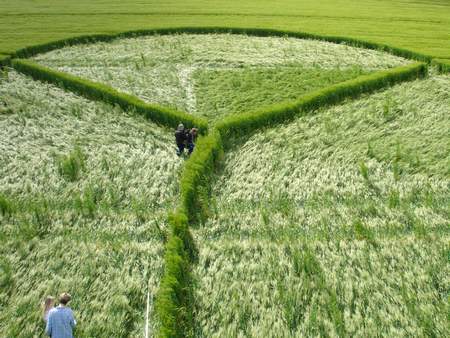
The crop appeared to be very lightly laid, some of which is down to its rapid recovery, but I didn’t feel that it had been particularly flat to the ground in the first place. As I walked around the formation it was very soft underfoot in most areas, and I could really hear the damage I was causing to the stems with each step. There are some 1ft wide pathways around the edges of each of the sections of laid crop. Next to the standing wall which separates the sections, there are counter-flows and in most places these are flatter to the ground than anywhere else. In the central standing wall there is a kink about ¾ of the way up, and on the north side of this wall, the counter flow only starts below this kink, towards the ‘base’ of the formation, and does not exist above it. 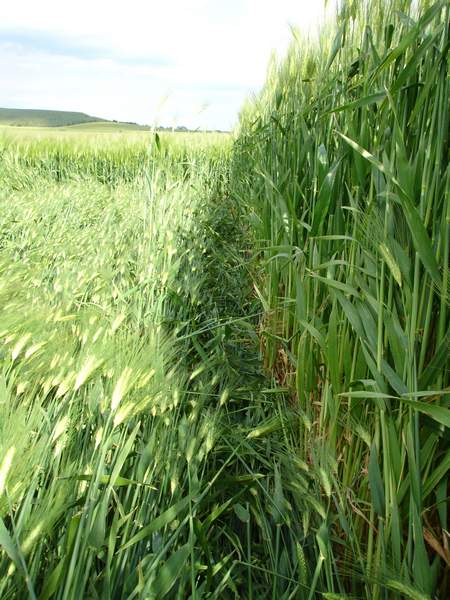
Around the outer edges these narrow pathways still exist, but follow the flow of the crop in the main sections. The dimensions of this crop formation are difficult to explain without a diagram, but the main measurements are 204ft wide, by 198ft long. The width of the standing sections of crop averages between 1ft and 2ft, and the diameter of the top section, with its predominantly circular form, is 102ft, incidentally this is precisely the length of my measuring tape! The crop flows clockwise in the top and right sections, and anti-clockwise in the left section of laid crop. I noted many interesting features to the lay of the crop in this formation, besides the light lay and counter-flowing pathways. Where the three ‘walls’ of standing crop converge in the centre, there is a small gap where the crop has been laid quite flat. At this point there is a small tuft of standing crop, just like you might find in the centre of a circular design, and around this tuft the laid crop flows very tightly from one section into another, in a clockwise direction. The crop flowing around the standing tuft shows no obvious signs of any damage. 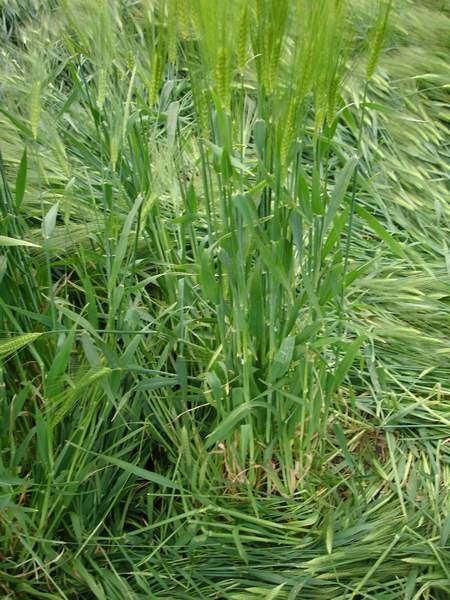
Tramline FeaturesAs the main flow of the crop crosses over tramlines there are two interesting features. The first is that next to each tramline is a thin curtain of standing crop, one or two stems thick, which appears to have not been laid at all. 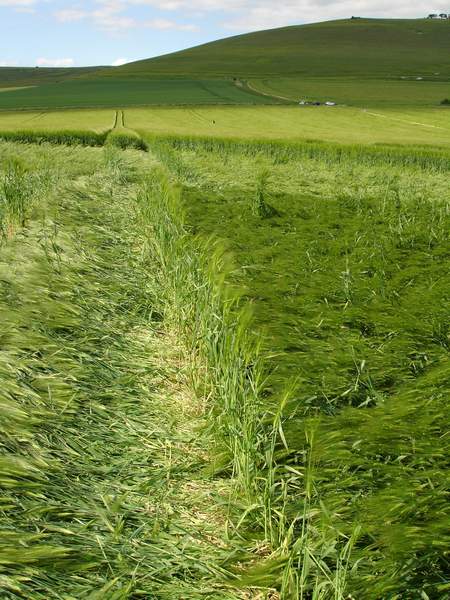
The crop flowing around each of the main sections either flows around these ‘curtains’ or stops before them as can be seen in both images. 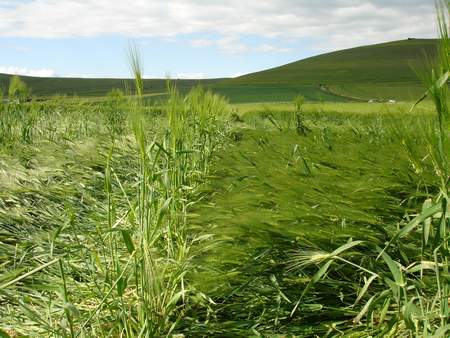
Where these ‘curtains’ do not exist the crop flows freely over the tramlines. At this point the ‘bridging effect’ which I discussed in the Bishop’s Sutton report, (due to its non-existence), is very apparent. The crop flowing over the tramline shows no sign of damage, and lays gently over the rut created by the tractor tyre. There is no evidence that this crop has ever been pushed into the tramline. 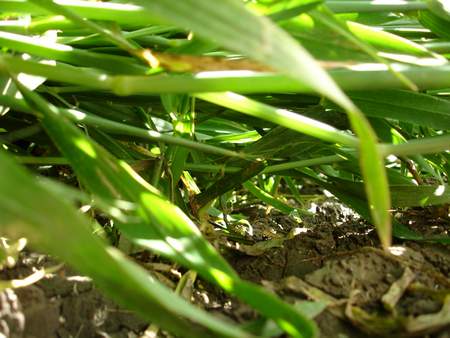
AlignmentThe whole formation is aligned east to west, with most of the lower section of standing crop following this line. The right hand wall of standing crop points towards Tan Hill, although not directly towards its summit, as can be seen from the photo below. 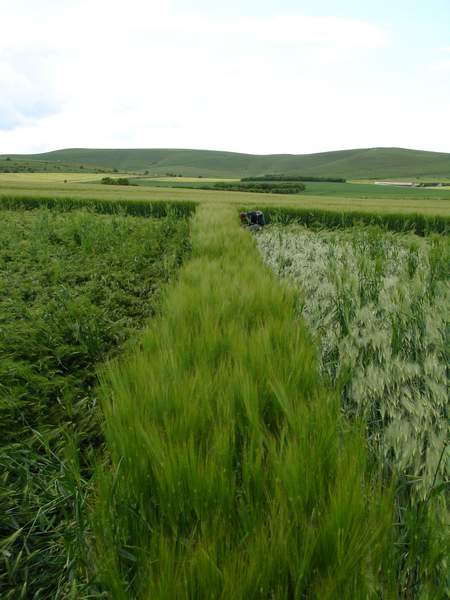
Looking towards the centre of the formation along the wall of standing crop on what is the left hand side if viewed from the ‘base’ of the formation, an alignment directly towards with the white horse on Milk Hill is apparent. 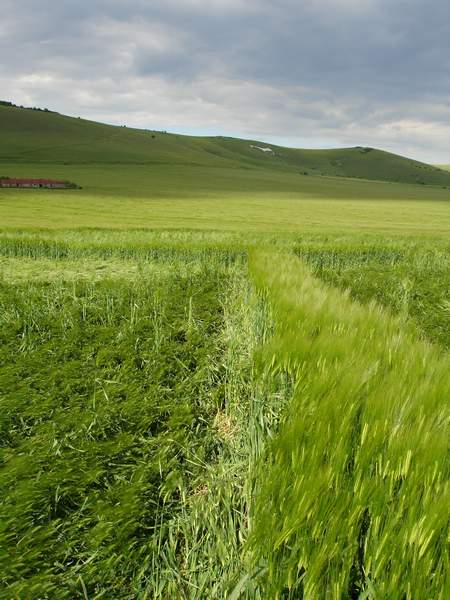
The centre of the top section of laid crop is the most typical, possibly because this section of laid crop is predominantly circular. The crop here fans out from the centre, and up to join the main body of flowing crop where it is laid particularly gently. There are some stems here which actually flow in the opposite direction. Where this occurs it appears there is some bending of the stems at the nodes. 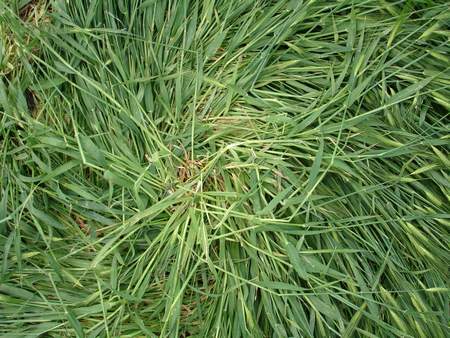
Crop DamageThroughout the formation in my opinion the crop was in very good condition. There was little evidence of any kinking or breakage of the stems, particularly in the main flows. Damage was noticeable in one or two of the narrow pathways surrounding the large areas of laid crop. These areas had been walked on quite heavily by those of us inside, and I think that this brings to our attention again just how much damage can be done by only a few visitors in not much time. One area where there was evidence of kinking in the stems was at the centre of the right hand section of laid crop. White lines were visible on a few stems at this point but no-where else in the formation, at least not that I could find! 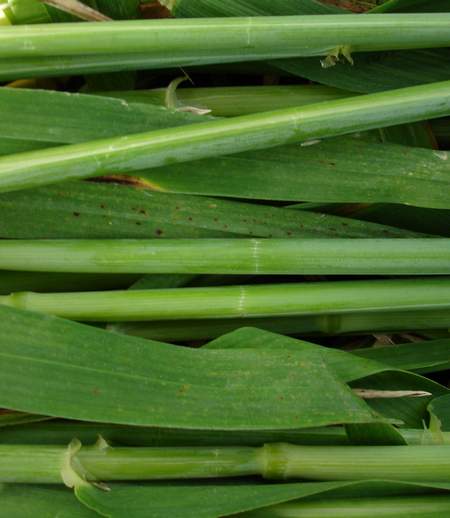
Finally, where the curved edges of the outer pathways meet the straight edges coming from the base, there are narrow pathways which continue out into the standing crop about 2 or 3ft. The laid crop within them appears to flow quite haphazardly outwards before tapering down to a point. I have no theory as to why these are present, but they are there! 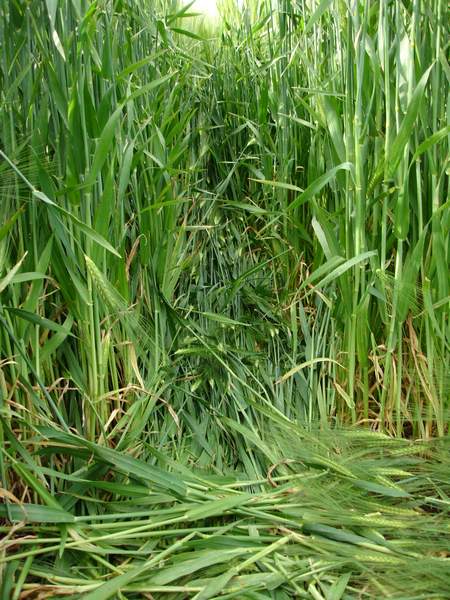
A lot to think about and a lot to talk about! This is certainly one of the more unusual designs we have seen so far this year and I look forward to seeing a geometrical analysis. I also look forward to more crop circles (we hope!) in lush wheat and barley fields. At this time of the year everything is so fresh (including the wind!) and it has been a pleasure to get to a formation before it gets squashed and trampled. Let’s hope for a busy summer (and warm too please!)… 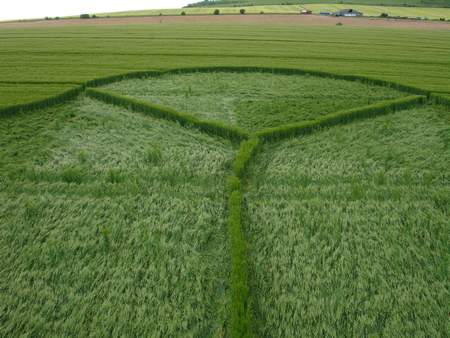
Crop Circle Summary
Alternative Websites |

